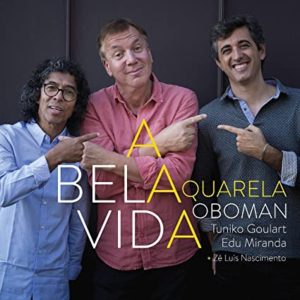 In een rijk gevuld choro-exposé horen we (alt)hoboïst Jean-Luc ‘Oboman’ Fillon op de nieuwe CD A Bela Vida, samen met de snarenspelers Edu Miranda (10-snarige mandoline) en Tuniko Goulart op de 7-snarige gitaar, aangevuld met percussionist Zé Luis Nascimento.
In een rijk gevuld choro-exposé horen we (alt)hoboïst Jean-Luc ‘Oboman’ Fillon op de nieuwe CD A Bela Vida, samen met de snarenspelers Edu Miranda (10-snarige mandoline) en Tuniko Goulart op de 7-snarige gitaar, aangevuld met percussionist Zé Luis Nascimento.
English version below
De choro is instrumentale muziek die ontstond in Rio de Janeiro (Brazilië) eind 19de eeuw. Alhoewel de naam lament, of klaagzang betekent, is de muziek snel, opzwepend, zeer melodisch met syncopische ritmes, subtiele modulaties en prachtige contrapunten (tegen-melodieën).
De choro is een muziekstijl waar het een voorwaarde is dat de instrumentalisten volledig op elkaar zijn ingespeeld. Alleen dan ontstaat er een algehele cohesie waarbij melodie, thema en improvisatie volledig in elkaar grijpen, prachtig om elkaar heen kronkelen en elkaar uitdagen in virtuositeit. Na de twee CD’s Choros do Brazil en Outros Choros do Brazil van hoboïst en musicus Jean-Luc ‘Oboman’ Fillon, Edu Miranda en Tuniko Goulart is er nu het opzwepende album Aquarela. We horen het prikkelende openingstuk Baiâo de Lacan van Guinga, van Ernesto Nazareth klinkt het filmische Brejeiro, met een knipoog naar de flamenco-muziek uit Zuid-Spanje. Zoals dat ook te horen is in Santa Morena van de in 1969 gestorven componist en mandolin-speler Jacob de Bandolim die ook Assanhado schreef. Maar ook staan er op Aquarela composities van Pixinguiha, een van de vernieuwers van de choro en werk van pianist/gitarist Egberto Gismonti, Hermeto Pascoal en Tom Jobim. Alle stukken klinken fris, soepel en worden met een ongeëvenaard gemak gespeeld. De heldere hobo kleurt fantastisch naast de mandolin en akoestische gitaar, aangevuld met fraai percussie-werk van Zé Luis Nascimento. Aquarela is een kleurrijk en ritmische aanrader.
English version
In a fine choro exposé we hear (alto) oboist Jean-Luc ‘Oboman’ Fillon on the new CD A Bela Vida, together with the string players Edu Miranda (10-string mandolin) and Tuniko Goulart on the 7-string guitar, supplemented with percussionist Zé Luis Nascimento.
The choro is instrumental music that originated in Rio de Janeiro (Brazil) in the late 19th century. Although the name means lament, the music is fast, uplifting, very melodic with syncopated rhythms, subtle modulations and counter points (counter-melodies).
The choro is a musical style where it is a condition that the instrumentalists are fully attuned to each other. Only then there will be an overall cohesion in which melody, theme and improvisation fully intertwine, beautifully twist around each other and challenge each other in virtuosity. After the two CDs Choros do Brazil and Outros Choros do Brazil by the oboe player and musician Jean-Luc ‘Oboman’ Fillon, Edu Miranda and Tuniko Goulart, there is now the exciting album Aquarela. We hear the stimulating opening piece Baiâo de Lacan written by Guinga, music composed by Ernesto Nazareth with the cinematic Brejeiro. The wonderful pieces Assanhado and Santa Morena, (with an eye wink to flamenco music from southern Spain) composed by mandolin player Jacob de Bandolim (who died in 1969) are recorded for this energetic album. There are also pieces composed by Pixinguiha, one of the innovators of the choro and work of pianist / guitarist Egberto Gismonti, Hermeto Pascoal and Tom Jobim. All pieces sound fresh, smooth and are played with unparalleled ease. The clear oboe colours fantastic next to the mandolin and acoustic guitar, supplemented with beautiful percussion work by Zé Luis Nascimento. Aquarela is an exciting and rhythmic album: highly recommended!
- A Bela Vida: Aquarela (Buda Records / Xango)
- Pictures: Malik Chaib
© Mattie Poels.

Geen reacties